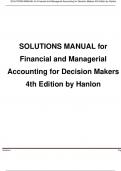Exam (elaborations)
SOLUTIONS MANUAL for Financial and Managerial Accounting for Decision Makers 4th Edition by Hanlon, Magee, Pfeiffer & Dyckman. ISBN 9781618533616. (All 24 Chapters) A+
- Course
- Institution
- Book
SOLUTIONS MANUAL for Financial and Managerial Accounting for Decision Makers 4th Edition by Hanlon, Magee, Pfeiffer & Dyckman. ISBN 9781618533616. (All 24 Chapters) A+
[Show more]




